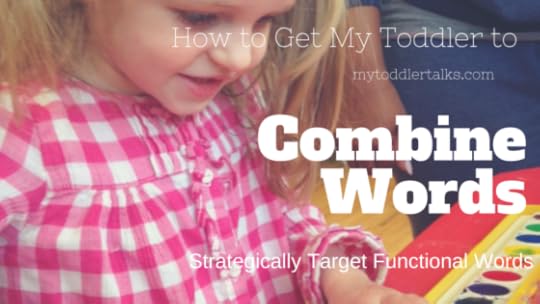How to Get My Toddler to Combine Words: Strategically Target Functional Words
How to Get My Toddler to Combine Words: Strategically Target Functional & Appropriate Words
My most recent posts have focused on going beyond single words by growing and varying vocabulary.
Have you have had any success growing your toddler’s vocabulary by focusing on tangible action words, observable describing words, and salient location words?
*Amazon Affiliate links included for your convenience.
If so, how is it going? Please leave a comment below…I would love for the comment section to act as a community for readers to exchange thoughts and ideas.
I’m assuming your toddler’s vocabulary has been growing (at least receptively – i.e. understanding more and more words), so I’m excited to share even more tips and tricks.
Are you ready?
Some research suggests that toddlers’ initial word combinations are not entirely random.
Toddlers like to talk about many of the following things:
Actions (especially funny and unexpected ones)
What people are doing (e.g. “Daddy eat’”)
What things receive an action (e.g. “Anna fell”)
Locations of things and people and where an action takes place
Where people and things are located (e.g. “Mommy here”)
Where an action took place (e.g. “in crib”)
Differences of opinions or preferences
When they don’t want to do something (e.g. “No!”)
When they disagree (e.g. “No!”)
When they want to deny or reject anything you say (e.g. “No!”)
Personal possessions
When something belongs to them, NOT you (e.g. “My” or “mine”)
Amusing words and sounds
May include words like: “Stinky”, “poop”, “boo”, “tickle, tickle”, “messy”, or “roar”. For more funny sounds, read Using Fun Sounds to Encourage Toddler Communication.
Simple social words
Many toddlers are encouraged to say “Hi” and “Bye” because parents train them at young age to be friendly and nice.
Please continue to stress tangible action words, observable describing words, and salient location words, but now do it strategically.
Strategically bombard your child with specific words to help him or her communicate essential needs, wants, and desires.
Tack on words from the above numbered list to the single words that he or she is already consistently and regularly saying.
If your child says, “doggie” every time you go for a walk, expand on it by saying, “Hi , doggie” or “Bye, doggie” every time you see a dog.
Or, every time you help dress your child use the same phrases like, “Shirt on”, “Pants on”, or “Shoes on”.
Eventually, you saying a particular phrase, like “Hi, doggie”, “Bye, doggie”, “Shirt on”, “Pants on”, will become part of the routine and your child will internalize it and eventually attempt to say it too.
ALERT – expect them to imitate your word combinations after hearing them several times. Then, one day soon you will be pleasantly surprised to hear them say the word combinations when you least expect it!
As always, I hope this has been helpful.
In need of some additional free and helpful resources? Please subscribe to my newsletter. I share information and handouts exclusively with my newsletter subscribers.
If you have enjoyed readingMy Toddler Talks: Strategies and Activities to Promote Your Child’s Language Development or Learning to Read is a Ball
or Learning to Read is a Ball , please help spread the word. Tell your friends, write an honest review on Amazon, click the social media buttons or personally give me your feedback. I love hearing from my readers and value your input.
, please help spread the word. Tell your friends, write an honest review on Amazon, click the social media buttons or personally give me your feedback. I love hearing from my readers and value your input.
Thanks for reading!
The post How to Get My Toddler to Combine Words: Strategically Target Functional Words appeared first on My Toddler Talks.




